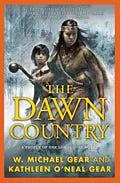The Dawn Country, a sequel to People of the Longhouse, is set during the Middle Iroquoian period in what is now New England. Archaeological evidence suggests that around 1400 A.D. the Iroquois went through a long period of violent warfare and divided into separate tribes which lived in large, fortified villages. Children growing up during such intense warfare must have suffered lasting psychological effects, and The Dawn Country portrays this with unflinching sympathy.
The Iroquois held mystical beliefs about the survival of human souls after physical death. Sorcerers, they believed, could enslave these souls through frightening, sometimes gruesome ceremonies. Vivid scenes bring this belief system alive for readers. People of the Longhouse introduced an evil sorceress, Gannajero, who buys and sells children for use as sex slaves. The Dawn Country opens following a devastating attack on a village. Amid the confusion, Gannajero buys new children to replace several who have escaped. The story follows numerous characters, including children who have escaped, have been left behind, or have been newly enslaved. Some of their parents, even though they come from villages at war with each other, band together to rescue the children. Koracoo, a woman war chief, leads the band. She wields an ancient war club. "It was old and made from a dark wood that did not grow in their country.... Throughout their territories, CorpseEye was known as a frightening magical weapon, capable of sniffing out enemies even at great distances."
There's plenty of violence, but the sexual abuse happens strictly offstage. Because there are so many main characters, the early part of the story may be confusing for those who have not read the previous novel. Both novels are part of the lengthy First North Americans series, whose settings range from Alaska in 13,000 B.C. to Florida in 6000 B.C. and New Mexico in 1100 A.D. Most can stand alone. The People of the Longhouse novels, though, are probably best read in order. (2011; 300 pages, including a Nonfiction Introduction and a Selected Bibliography)




